What Is Data Governance? A Complete Guide From First Principles
Understanding the foundations, frameworks, and business value of data governance
"Our executives keep talking about 'data governance,' but what exactly is it? And why do we need it?"
This question comes up in boardrooms and strategy meetings across every industry. Leaders know their organizations need to "govern data better," but there's often confusion about what that actually means in practical terms.
Is data governance about compliance? Technology? Business processes? Risk management? The answer is: all of the above, but in a coordinated, strategic way that most organizations haven't figured out yet.
The confusion isn't surprising. Data governance draws from multiple disciplines—risk management, compliance, operations, technology—and combines them in ways that didn't exist when most business leaders were developing their expertise. It's governance for the digital age, addressing challenges that previous generations of leaders never had to consider.
But here's the thing: every successful organization already understands governance in other contexts. They have financial governance, operational governance, and strategic governance. Data governance follows the same fundamental principles, applied to an organization's most valuable and rapidly growing asset: its data.
In this guide, we'll build understanding of data governance from first principles—starting with the fundamental governance concepts that apply universally, then systematically applying them to the data context. We'll answer the most common questions executives ask about data governance while defining key terminology and explaining core concepts.
The First Principle: All governance systems solve the same fundamental challenge: how to coordinate group behavior to achieve shared objectives while managing individual interests and risks.
By the end, you'll understand not just what data governance is, but why it exists, how it works, and how to evaluate whether your organization is doing it well.
Understanding Governance: The Foundation
Common Question: "Before we talk about data governance, what exactly is governance in general?"
Before we can understand data governance, we need to understand governance itself. This is our First Principle: governance is humanity's solution to a fundamental coordination challenge.
What Governance Actually Is
At its core, governance is the system of rules, practices, and processes by which an organization (or any group) is directed, controlled, and held accountable. It answers three fundamental questions:
- Who makes decisions? (Authority and accountability)
- How are decisions made? (Processes and procedures)
- How do we ensure good outcomes? (Monitoring and enforcement)
Every form of governance—from national governments to sports leagues to corporate boards—addresses these same basic questions within their specific context.
Governance Across Different Domains
Let's examine how governance works in familiar contexts to understand the underlying patterns:
Societal Governance
Purpose: Coordinate millions of people for collective benefit while protecting individual rights
Key Elements:
- Authority Structure: Constitution, elected officials, courts
- Decision Processes: Legislative procedures, judicial review, democratic elections
- Accountability Mechanisms: Elections, audits, free press, judicial oversight
Example: Traffic laws govern how we drive. Clear rules (speed limits, traffic signals), enforcement mechanisms (police, courts), and accountability (fines, license suspension) create a system where millions of individual drivers can coordinate safely.
Corporate Governance
Purpose: Ensure companies are run in the interests of shareholders and stakeholders
Key Elements:
- Authority Structure: Board of directors, executive leadership, audit committees
- Decision Processes: Board meetings, shareholder votes, executive decision rights
- Accountability Mechanisms: Financial reporting, audits, regulatory compliance, shareholder activism
Example: Financial governance ensures accurate reporting. Clear standards (GAAP), defined processes (audit procedures), and accountability mechanisms (SOX compliance, auditor independence) create trust in financial markets.
Sports Governance
Purpose: Ensure fair competition and maintain integrity of the sport
Key Elements:
- Authority Structure: League commissioners, referees, governing bodies
- Decision Processes: Rule-making committees, officiating procedures, disciplinary processes
- Accountability Mechanisms: Replay reviews, fines, suspensions, appeals processes
Example: Professional sports leagues have elaborate governance to ensure fair play. Clear rules, trained officials, instant replay, and disciplinary procedures maintain competitive integrity.
Military Governance
Purpose: Ensure coordinated action under high-stakes conditions
Key Elements:
- Authority Structure: Chain of command, rank hierarchy, specialized roles
- Decision Processes: Mission planning, operational procedures, rules of engagement
- Accountability Mechanisms: After-action reviews, courts martial, inspector generals
Example: Military operations require precise coordination. Clear command structures, standard operating procedures, and accountability mechanisms enable complex operations under extreme conditions.
The Common Patterns
Across all these domains, effective governance shares common characteristics:
Clear Authority: Everyone knows who has decision-making power in different situations Defined Processes: Standard procedures for how decisions are made and implemented
Accountability Mechanisms: Ways to ensure decisions are made properly and achieve intended outcomes Adaptability: Ability to evolve as circumstances change Proportionality: Governance overhead proportionate to the risks and complexity involved
These same patterns apply to data governance, but within the specific context of managing organizational data assets.
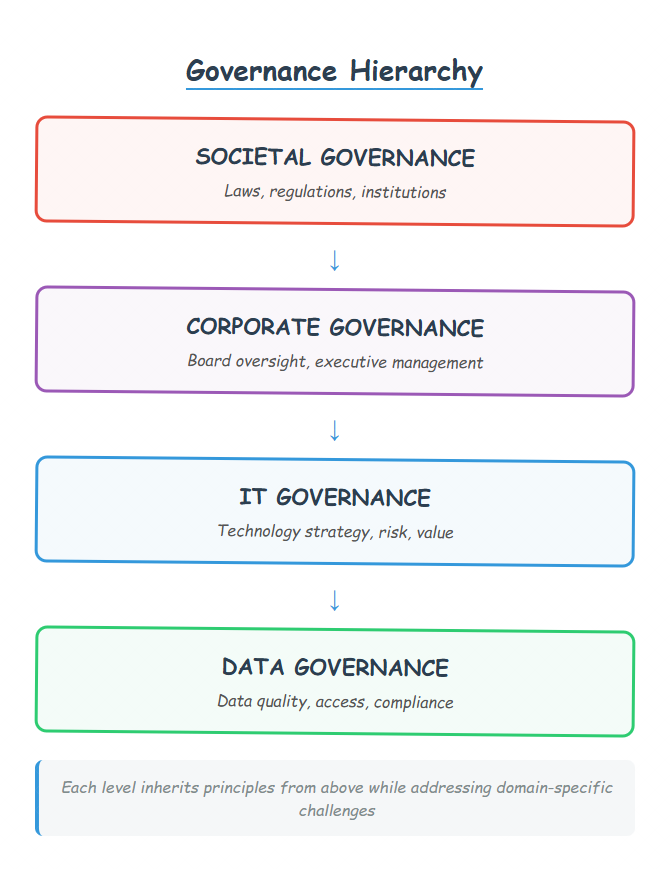
Each level of governance inherits principles from above while addressing domain-specific challenges.
IT Governance: The Bridge to Data Governance
Before jumping directly to data governance, it's helpful to understand IT governance, which provides the immediate context for how organizations think about governing technology assets.
What IT Governance Covers
IT Governance ensures that information technology supports and enables business objectives while managing technology-related risks and optimizing resource utilization.
Key Areas:
- Strategic Alignment: Ensuring IT investments support business strategy
- Value Delivery: Optimizing the value IT creates for the business
- Risk Management: Managing technology-related risks (security, operational, compliance)
- Resource Management: Optimizing technology investments and capabilities
- Performance Measurement: Monitoring IT performance and business value creation
IT Governance Frameworks
Several established frameworks guide IT governance:
COBIT (Control Objectives for Information and Related Technologies)
- Comprehensive framework for IT governance and management
- Focuses on five principles: stakeholder needs, enterprise coverage, single framework, holistic approach, governance/management distinction
ITIL (Information Technology Infrastructure Library)
- Best practices for IT service management
- Focuses on aligning IT services with business needs and improving operational efficiency
ISO/IEC 38500
- International standard for corporate governance of IT
- Emphasizes direction, evaluation, and monitoring of IT use
How Data Governance Extends IT Governance
Data governance inherits many concepts from IT governance but focuses specifically on data assets:
Similarities:
- Strategic alignment with business objectives
- Risk management focus
- Value optimization emphasis
- Need for clear accountability and processes
Key Differences:
- Asset Focus: Data vs. technology infrastructure
- Usage Patterns: Data is consumed and transformed, technology is operated
- Stakeholder Base: Broader business involvement in data decisions
- Compliance Requirements: Specific regulations around data privacy and protection
- Value Creation: Data often creates value through use rather than operation
This foundation helps explain why organizations with mature IT governance often find data governance concepts familiar, even if the specific practices are different.
What Is Data Governance?
Common Question: "Now that I understand governance in general, how does this apply specifically to data?"
Now we can define data governance with proper context. Data governance is the system of authority, accountability, and decision-making for organizational data assets that ensures data supports business objectives while managing associated risks and optimizing value creation.
Like other forms of governance, data governance answers the fundamental questions within the context of data management:
Who makes decisions about data? (Data owners, stewards, governance councils)
How are data decisions made? (Policies, processes, approval workflows)
How do we ensure good outcomes? (Quality monitoring, compliance audits, value measurement)
Why Data Governance Exists: The Fundamental Drivers
Data governance exists because data has become too important, too complex, and too risky to manage informally. Several fundamental drivers create the need for systematic data governance:
The Scale Problem
Modern organizations generate and manage data at unprecedented scales:
- Volume: Terabytes to petabytes of data across hundreds of systems
- Variety: Structured databases, unstructured documents, real-time streams, external datasets
- Velocity: Real-time processing requirements and rapidly changing data needs
- Users: Hundreds or thousands of people across different functions accessing and using data
Without governance, this scale creates chaos: conflicting definitions, quality issues, security gaps, and duplicated efforts.
The Value Problem
Data has become a strategic asset that creates competitive advantage:
- Decision Making: Data drives critical business decisions across all functions
- Product Development: Data enables new products, services, and business models
- Operational Efficiency: Data optimization reduces costs and improves performance
- Customer Experience: Data personalization improves customer satisfaction and loyalty
Without governance, organizations can't consistently realize this value because they can't trust their data or access it efficiently.
The Risk Problem
Data creates new categories of business risk:
- Privacy Risk: Mishandling personal data leads to regulatory fines and reputation damage
- Security Risk: Data breaches expose sensitive information and create liability
- Compliance Risk: Regulatory requirements (GDPR, CCPA, SOX) create legal obligations
- Operational Risk: Poor data quality leads to bad decisions and operational failures
Without governance, these risks compound and can threaten business viability.
The Complexity Problem
Data management involves complex technical and business considerations:
- Technical Complexity: Multiple platforms, integration challenges, performance requirements
- Business Complexity: Different functions have different data needs and definitions
- Regulatory Complexity: Multiple jurisdictions and evolving privacy laws
- Organizational Complexity: Cross-functional coordination and change management
Without governance, this complexity overwhelms informal management approaches.
The Business Case for Data Governance
Organizations implement data governance because the costs of not having it exceed the costs of implementing it:
Cost of Poor Data Governance:
- Data quality issues cost large organizations $15-25 million annually (Gartner)
- Compliance violations can result in fines up to 4% of annual revenue (GDPR)
- Security breaches average $4.45 million per incident (IBM Security)
- Poor data decisions compound operational inefficiencies across all business functions
Benefits of Good Data Governance:
- 30-50% reduction in time to access reliable data for decision-making
- 60-80% reduction in data-related compliance and security incidents
- 20-30% improvement in operational efficiency through better data quality
- Faster development of data-driven products and services
The business case becomes compelling when organizations reach sufficient scale, complexity, or risk exposure that informal data management creates more problems than systematic governance solves.
Data Governance Frameworks and Standards
Common Question: "What frameworks or standards should we follow for data governance?"
Multiple frameworks provide structure for implementing data governance. Understanding the major frameworks helps organizations choose approaches that fit their specific needs and contexts.
DAMA-DMBOK Framework
The Data Management Association (DAMA) provides the most comprehensive framework through the Data Management Body of Knowledge (DMBOK).
Core Knowledge Areas:
- Data Governance - Overall coordination and accountability
- Data Architecture - Structure and integration design
- Data Modeling and Design - Data requirements and structure definition
- Data Storage and Operations - Implementation and operational management
- Data Security - Protection and access control
- Data Integration and Interoperability - Movement and sharing
- Data Warehousing and Business Intelligence - Analytics infrastructure
- Reference and Master Data - Critical data standardization
- Data Quality - Accuracy, completeness, and reliability
- Metadata - Data about data
- Document and Content Management - Unstructured data handling
Strengths: Comprehensive coverage, industry standard, detailed best practices Best For: Large organizations needing comprehensive data management programs
COBIT for Data Governance
COBIT extends its IT governance framework to include data governance through specific practices and controls.
Key Components:
- Alignment: Data management aligned with business strategy
- Value: Optimization of data investments and value creation
- Risk: Management of data-related risks
- Resources: Optimization of data-related resources and capabilities
- Quality: Measurement and improvement of data management practices
Strengths: Integration with IT governance, control-focused approach, audit-friendly Best For: Organizations with mature IT governance seeking to extend to data
ISO/IEC 38500 Extended for Data
ISO/IEC 38500 governance principles applied specifically to data management.
Core Principles Applied to Data:
- Responsibility: Clear accountability for data-related decisions and outcomes
- Strategy: Data management aligned with business strategy and objectives
- Acquisition: Thoughtful decisions about data sources and investments
- Performance: Monitoring data management performance and business value
- Conformance: Compliance with regulations and organizational policies
- Human Behavior: Consideration of how people actually work with data
Strengths: International standard, principle-based approach, governance focus Best For: Organizations needing internationally recognized governance standards
Industry-Specific Frameworks
Many industries have developed specialized frameworks:
Financial Services: Basel III, COSO, GDPR compliance frameworks Healthcare: HIPAA compliance, HL7 standards, clinical data governance Government: FISMA, Federal Data Strategy, open data requirements Manufacturing: Industry 4.0 data standards, supply chain data governance
Framework Selection Considerations
Choose frameworks based on:
- Industry Requirements: Regulatory and industry-specific needs
- Organizational Maturity: Current governance and data management capabilities
- Scale and Complexity: Size and complexity of data environment
- Resource Availability: Implementation and ongoing management resources
- Integration Needs: How data governance fits with existing governance structures
Most organizations benefit from hybrid approaches that combine elements from multiple frameworks rather than rigid adherence to a single methodology.
Emerging Concepts in Modern Data Governance
Common Question: "What's changing in data governance? What new concepts should we be aware of?"
Data governance has evolved significantly in the past five years, driven by new technologies, regulatory changes, and organizational approaches. Understanding these emerging concepts helps organizations build governance that's aligned with modern data practices.
Data Mesh and Federated Governance
Concept: Treating data as products owned by domain teams rather than centrally managed assets
Key Principles:
- Domain Ownership: Business domains own their data products end-to-end
- Data as a Product: Data treated like software products with clear ownership and SLAs
- Self-Serve Infrastructure: Centralized platform enabling domain autonomy
- Federated Computational Governance: Automated policy enforcement across domains
Governance Implications: Shifts from centralized control to federated standards with domain accountability
Data Products and Product Thinking
Concept: Applying product management principles to data assets
Key Elements:
- Product Managers for Data: Dedicated roles managing data products like software products
- User Experience Focus: Emphasis on data consumer experience and usability
- Product Lifecycle Management: Managing data products from conception to retirement
- Value-Based Metrics: Measuring success through user adoption and business value
Governance Impact: Governance becomes product-enabling rather than compliance-focused
Privacy Engineering and Privacy by Design
Concept: Building privacy protection into data systems from the ground up rather than adding it later
Technical Approaches:
- Differential Privacy: Mathematical privacy guarantees for data analysis
- Homomorphic Encryption: Computation on encrypted data
- Federated Learning: Model training without centralizing data
- Synthetic Data: Artificially generated data that preserves statistical properties
Governance Evolution: From policy-based to technology-enabled privacy protection
AI Governance Integration
Concept: Extending data governance to cover artificial intelligence and machine learning systems
Key Areas:
- Model Governance: Managing AI model lifecycle, performance, and risk
- Algorithmic Fairness: Ensuring AI systems don't create bias or discrimination
- Explainable AI: Requirements for transparency in AI decision-making
- AI Ethics: Frameworks for responsible AI development and deployment
Governance Expansion: Data governance expanding to cover AI/ML as data-driven systems proliferate
Cloud-Native Governance
Concept: Governance approaches designed for cloud-native, distributed data architectures
Key Features:
- API-First Governance: Policy enforcement through APIs rather than manual processes
- Container-Native: Governance embedded in containerized data workloads
- Event-Driven: Real-time governance actions triggered by data events
- Multi-Cloud: Governance across multiple cloud providers and hybrid environments
Architectural Impact: Governance becoming infrastructure code rather than manual processes
DataOps and Governance Automation
Concept: Applying DevOps principles to data operations including governance
Automation Areas:
- Policy as Code: Governance policies defined and enforced through code
- Automated Quality Testing: Continuous data quality validation in pipelines
- Self-Service Governance: Users can request access and provision resources automatically
- Continuous Compliance: Automated compliance monitoring and reporting
Operational Impact: Governance becoming more automated and less bureaucratic
These emerging concepts share a common theme: making governance more automated, user-friendly, and aligned with modern data practices while maintaining necessary controls and compliance.
Data Governance Component Framework
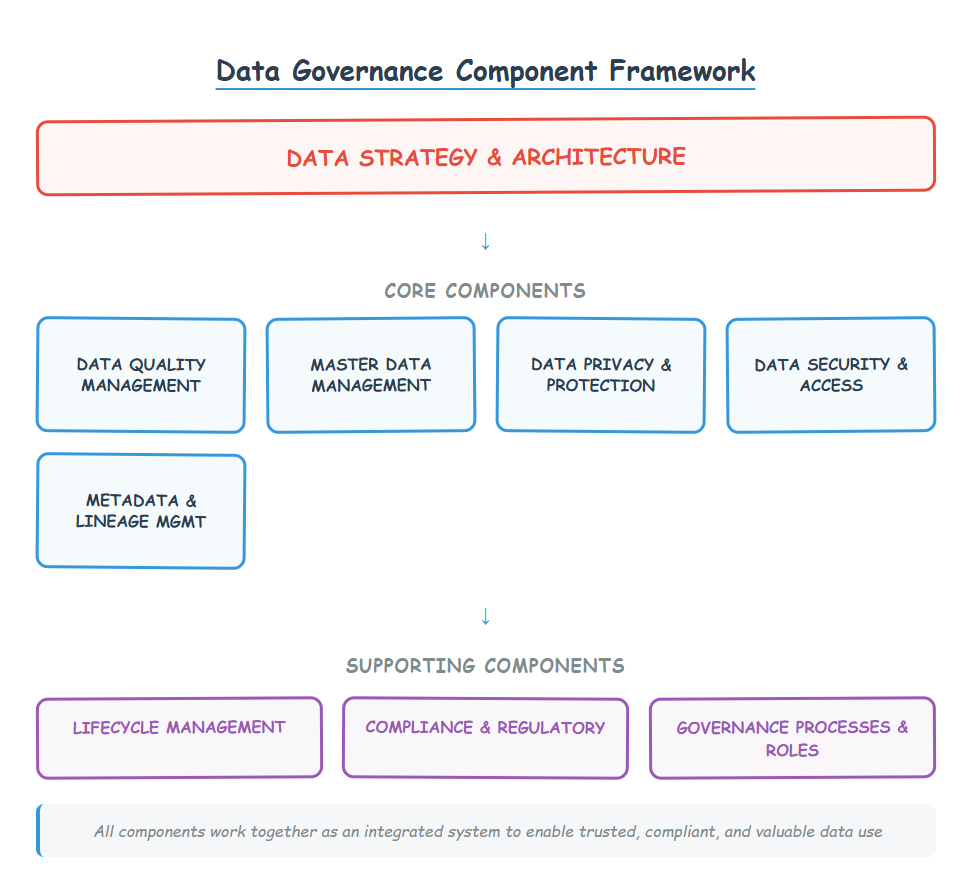
All components work together as an integrated system to enable trusted, compliant, and valuable data use.
Major Components of Data Governance
Common Question: "What are the main parts of data governance that we need to understand and implement?"
Data governance consists of several major components that work together as an integrated system. Different frameworks emphasize different components, but most comprehensive approaches include these core areas:
1. Data Strategy and Architecture
Purpose: Ensure data management supports business strategy and provides scalable foundation for growth
Key Elements:
- Data Strategy: High-level approach for using data to create competitive advantage
- Data Architecture: Technical structure for storing, integrating, and accessing data
- Data Models: Standardized representations of business concepts and relationships
- Integration Patterns: Standardized approaches for sharing data across systems
Why It Matters: Without strategic alignment and architectural foundation, data governance becomes tactical compliance activity rather than business enabler.
Business Impact: Organizations with clear data strategy and architecture deliver analytics projects 40-60% faster and achieve better business outcomes.
2. Data Quality Management
Purpose: Ensure data is accurate, complete, consistent, and reliable enough to support business decisions and operations
Key Elements:
- Quality Standards: Specific, measurable requirements for data accuracy and completeness
- Quality Monitoring: Automated and manual processes for detecting quality issues
- Issue Resolution: Workflows for investigating and correcting data problems
- Root Cause Analysis: Systematic approaches for preventing recurring quality issues
Why It Matters: Poor data quality undermines trust in data-driven decisions and creates operational inefficiencies across the organization.
Business Impact: Data quality improvements typically deliver 20-30% improvements in operational efficiency and decision accuracy.
Example Quality Standards:
- Customer contact information: 99% accuracy, validated monthly
- Financial transaction data: 100% completeness for required fields, validated daily
- Product catalog data: Consistent formatting and terminology across all systems
3. Master Data Management (MDM)
Purpose: Create authoritative, consistent definitions and records for critical business entities across the organization
Key Elements:
- Master Data Identification: Determining which business entities require standardization (customers, products, suppliers, locations)
- Golden Records: Authoritative versions of master data combining information from multiple sources
- Data Stewardship: Ongoing maintenance and quality assurance for master data
- Integration Services: Technical services for accessing and updating master data across systems
Why It Matters: Inconsistent definitions of basic business concepts (like "customer" or "product") create confusion, inefficiency, and poor decision-making.
Business Impact: Effective MDM typically reduces data integration costs by 50-70% and improves business process efficiency by 15-25%.
Common Master Data Domains:
- Customer: Individual and organizational customers, prospects, and contacts
- Product: Products, services, and related catalog information
- Supplier: Vendors, partners, and service providers
- Employee: Personnel information and organizational structure
- Location: Facilities, geographic regions, and operational locations
4. Data Privacy and Protection
Purpose: Ensure appropriate protection of sensitive data while enabling legitimate business use
Key Elements:
- Data Classification: Systematic categorization of data based on sensitivity and protection requirements
- Privacy Controls: Technical and procedural controls for protecting personal and sensitive data
- Consent Management: Processes for obtaining, tracking, and honoring data subject preferences
- Access Controls: Role-based restrictions on who can access what data under what circumstances
Why It Matters: Privacy regulations like GDPR and CCPA create legal obligations, while data breaches create financial and reputational risks.
Business Impact: Strong privacy programs reduce compliance costs by 30-50% and avoid potentially devastating regulatory fines and breach costs.
Key Privacy Regulations:
- GDPR (General Data Protection Regulation): EU regulation affecting any organization processing EU residents' data
- CCPA (California Consumer Privacy Act): California regulation with broader US implications
- HIPAA (Health Insurance Portability and Accountability Act): US healthcare data protection
- Industry-Specific: Financial services, telecommunications, and other sector-specific requirements
5. Data Security and Access Management
Purpose: Protect data from unauthorized access, modification, or destruction while enabling appropriate business use
Key Elements:
- Access Control: Authentication and authorization systems ensuring only authorized users access data
- Encryption: Protection of data in transit and at rest
- Monitoring and Auditing: Detection and investigation of unauthorized or suspicious data access
- Incident Response: Procedures for responding to security breaches or suspected compromises
Why It Matters: Data security breaches create financial, legal, and reputational risks while potentially disrupting business operations.
Business Impact: Mature data security programs reduce security incidents by 60-80% and minimize breach costs when incidents occur.
6. Data Lifecycle Management
Purpose: Manage data from creation through disposal in compliance with business and regulatory requirements
Key Elements:
- Retention Policies: Rules for how long different types of data should be kept
- Archival Procedures: Processes for moving inactive data to lower-cost storage while maintaining accessibility
- Disposal Processes: Secure deletion of data when retention periods expire
- Compliance Tracking: Monitoring and reporting on lifecycle compliance
Why It Matters: Regulatory requirements mandate specific retention periods, while storage costs and security risks increase with data volume.
Business Impact: Effective lifecycle management reduces storage costs by 40-60% and ensures compliance with retention requirements.
7. Metadata Management
Purpose: Provide comprehensive information about data assets to enable discovery, understanding, and appropriate use
Key Elements:
- Business Metadata: Definitions, business rules, and context for data elements
- Technical Metadata: Information about data structures, sources, and processing
- Operational Metadata: Information about data quality, usage patterns, and performance
- Data Lineage: Tracking of how data flows through systems and transformations
Why It Matters: Without good metadata, data becomes difficult to find, understand, and use appropriately.
Business Impact: Comprehensive metadata reduces time to access data by 50-70% and improves data reuse across projects.
8. Compliance and Regulatory Management
Purpose: Ensure data management practices meet regulatory requirements and support audit activities
Key Elements:
- Regulatory Mapping: Understanding which regulations apply to different data types and business activities
- Control Implementation: Technical and procedural controls that demonstrate compliance
- Audit Trail: Comprehensive logging of data access and modification activities
- Reporting Capabilities: Ability to demonstrate compliance to regulators and auditors
Why It Matters: Regulatory violations can result in significant fines, while compliance failures can restrict business activities.
Business Impact: Proactive compliance management reduces audit costs by 40-60% and avoids regulatory violations.
How Data Governance Fits with Data Strategy and Operations
Data governance doesn't exist in isolation—it must integrate seamlessly with data strategy and day-to-day data operations to create business value.
The Strategic Integration Model
Data Strategy defines what you want to achieve with data and how data will create competitive advantage for your organization.
Data Governance ensures you can achieve your data strategy objectives by managing data as a strategic asset with appropriate quality, security, and compliance controls.
Data Operations implements both strategy and governance through day-to-day data management activities.
Think of this as:
- Strategy = Your destination and route
- Governance = Your navigation system and safety protocols
- Operations = Your daily driving
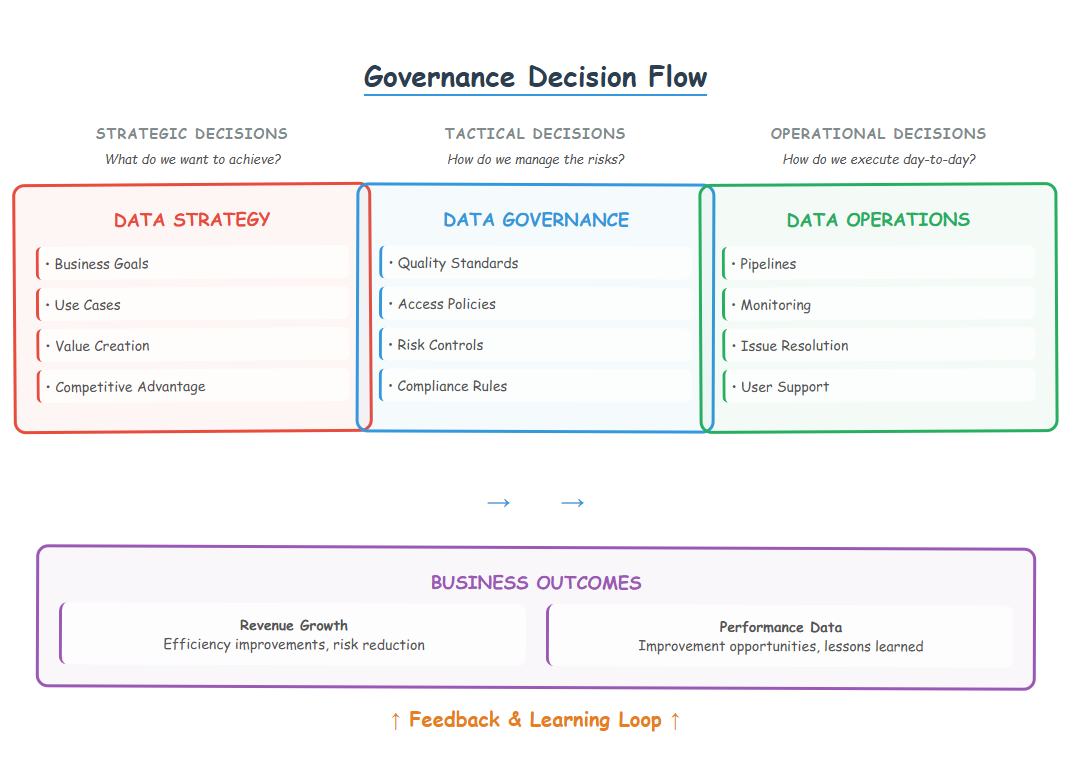
Integration Touch Points
Data strategy, governance, and operations must integrate seamlessly to create business value. Strategy-governance integration involves ensuring high-priority use cases have appropriate quality and compliance controls, with governance identifying data-related risks that might affect strategy execution while building capabilities that enable strategic initiatives. Governance-operations integration requires operations teams to implement governance policies through daily procedures, execute quality standards, follow escalation procedures for data problems, and provide feedback that informs governance improvements. The most successful organizations embed governance within strategy and operations teams rather than treating it as a separate function, ensuring governance decisions are made by people accountable for business results.
Organizational Integration Patterns
Integrated Model (Recommended for most organizations)
- Data governance embedded within data strategy and operations teams
- Governance decisions made by business leaders accountable for data outcomes
- Governance processes integrated with operational workflows
- Shared metrics and objectives across strategy, governance, and operations
Separate Model (Common but problematic)
- Data governance as standalone function separate from strategy and operations
- Governance decisions made by specialized governance team
- Governance processes separate from operational workflows
- Different metrics and objectives for governance vs. operations
The integrated model typically delivers better business outcomes because governance decisions are made by people accountable for business results rather than compliance specialists.
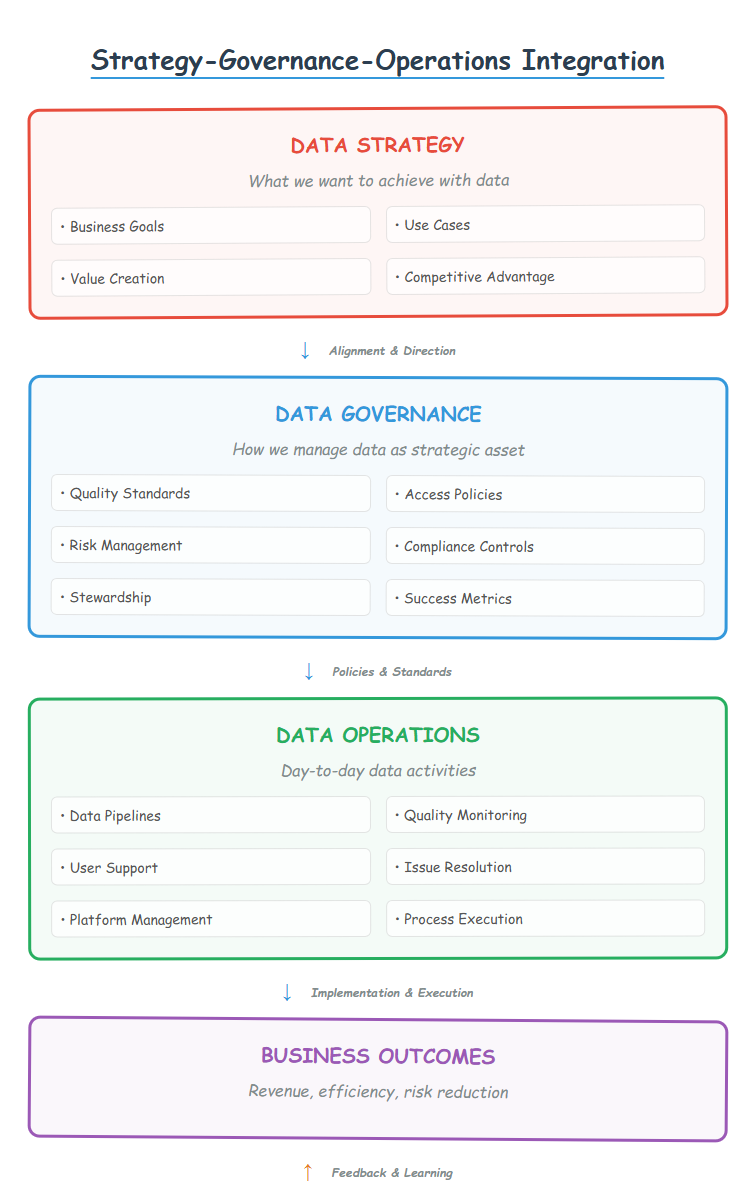
Who Should Lead Data Governance?
Successful data governance requires clear leadership and accountability, but the optimal organizational model depends on several factors.
Leadership Options and Trade-offs
Business-Led Governance (Recommended)
Structure: Senior business leader (CDO, COO, or business unit head) leads governance with support from IT and compliance teams
Pros:
- Direct accountability for business outcomes
- Better alignment with business priorities
- Faster decision-making on business trade-offs
- Higher credibility with business stakeholders
Cons:
- May lack technical expertise for complex decisions
- Risk of inconsistent standards across business units
- Potential conflicts between business units
Best For: Organizations where data is core to business strategy and competitive advantage
IT-Led Governance
Structure: CIO or senior IT leader leads governance with business stakeholder input
Pros:
- Strong technical expertise for platform and security decisions
- Consistent implementation across technical infrastructure
- Clear accountability for compliance and risk management
- Established governance processes from IT experience
Cons:
- Risk of technology-first rather than business-first approach
- Lower business stakeholder engagement
- May prioritize technical considerations over business value
- Perception of governance as IT constraint rather than business enabler
Best For: Organizations with less mature data strategies or heavy compliance requirements
Shared Leadership Model
Structure: Joint leadership between business and IT with clear decision rights and escalation procedures
Pros:
- Combines business and technical expertise
- Balanced decision-making across different considerations
- Shared accountability for outcomes
Cons:
- More complex decision-making processes
- Potential for conflicts and deadlock
- Requires strong collaboration culture
- May slow decision-making
Best For: Large organizations with complex data environments and strong collaborative culture
Essential Leadership Capabilities
Regardless of organizational model, effective data governance leadership requires:
Business Acumen: Understanding of how data creates business value and competitive advantage
Technical Understanding: Sufficient technical knowledge to make informed decisions about data platforms and tools
Risk Management: Experience managing compliance, security, and operational risks
Change Management: Skills for driving organizational change and cultural transformation
Stakeholder Management: Ability to coordinate across multiple business functions and technical teams
Governance Roles and Responsibilities
Executive Sponsor
Role: Senior executive accountable for governance outcomes and resource allocation
Responsibilities: Strategic direction, resource approval, escalation resolution, external stakeholder management
Data Governance Council
Role: Cross-functional leadership team making governance policy decisions
Responsibilities: Policy development, priority setting, conflict resolution, resource allocation
Data Owners
Role: Business leaders accountable for specific data domains (customer data, financial data, etc.)
Responsibilities: Business requirements, quality standards, access policies, compliance assurance
Data Stewards
Role: Operational roles managing day-to-day governance activities
Responsibilities: Quality monitoring, issue resolution, access administration, policy implementation
Governance Office
Role: Administrative support for governance processes and coordination
Responsibilities: Process management, training, reporting, tool administration
Data Team Evolution: From Startup to Enterprise
Common Question: "How should we organize our data team as we grow, and how does governance fit?"
Data team structure and governance approaches evolve as organizations scale. Understanding this evolution helps leaders plan appropriate governance models for their current and future state.
Governance Model by Team Size
Teams of 5-10 People (Centralized)
- Governance Approach: Informal, leader-driven
- Key Roles: Data lead acts as informal data owner and steward
- Focus: Basic data quality, simple access controls
- Tools: Spreadsheets, basic documentation
- Success Factors: Clear leadership, simple processes
Teams of 15-30 People (Hybrid)
- Governance Approach: Basic formal structure
- Key Roles: Dedicated part-time governance role, business data stewards
- Focus: Essential policies, quality monitoring, compliance basics
- Tools: Basic data catalog, quality dashboards
- Success Factors: Clear policies, business engagement
Teams of 45-75 People (Federated)
- Governance Approach: Formal governance framework
- Key Roles: Governance manager, business data owners, technical stewards
- Focus: Comprehensive governance program, automation
- Tools: Enterprise data catalog, governance platform
- Success Factors: Executive sponsorship, cross-functional cooperation
Teams of 100+ People (Decentralized)
- Governance Approach: Federated business-led model
- Key Roles: Governance council, business unit data teams, central platform team
- Focus: Enterprise-wide standards, business unit autonomy
- Tools: Federated governance platforms, self-service capabilities
- Success Factors: Strong governance culture, consistent standards
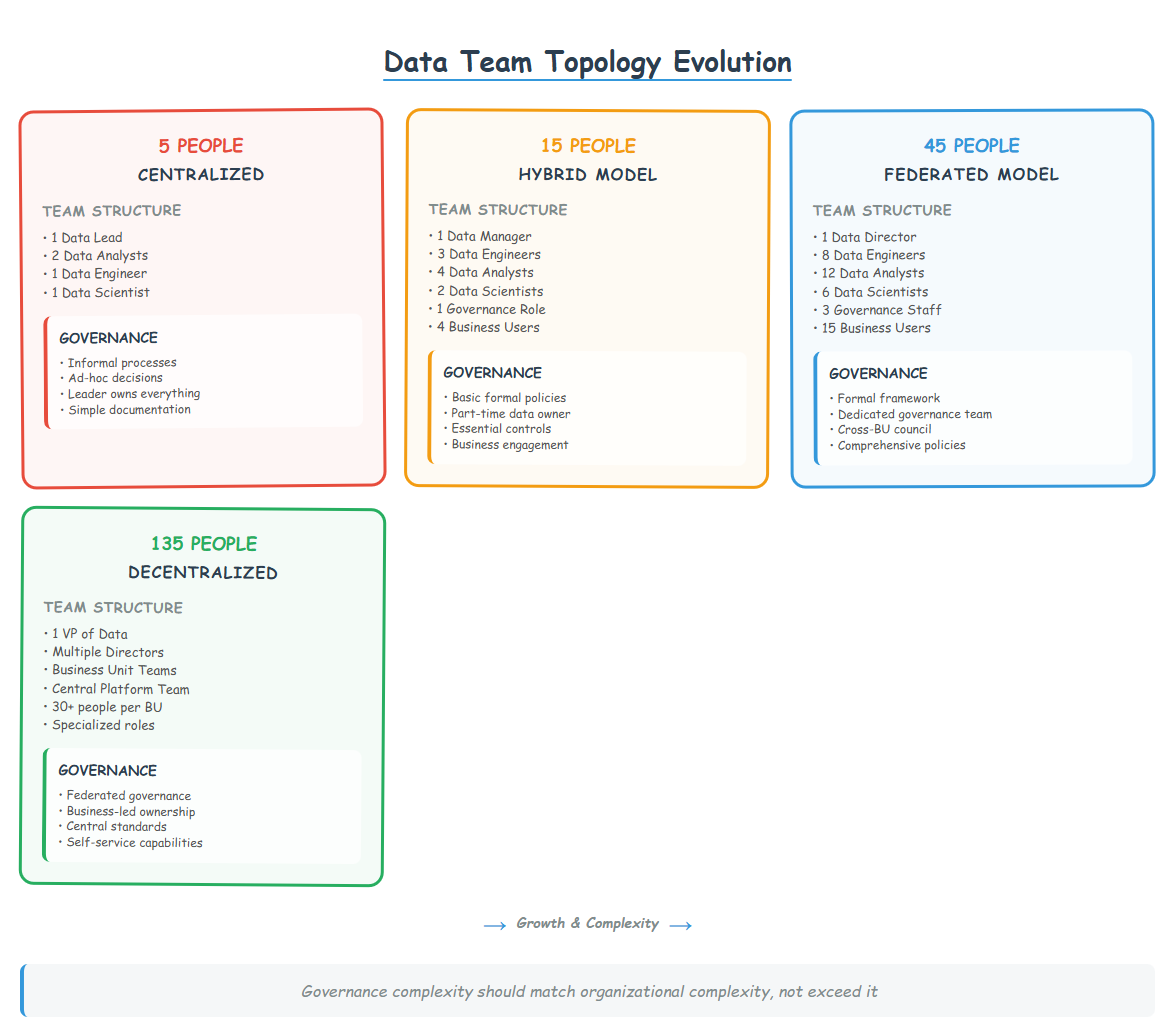
The key insight: governance complexity should match organizational complexity, not exceed it.
Key Activities for Business Impact
Effective data governance creates business impact through specific activities:
Value-Creating Activities
• Business Glossary Management: Authoritative definitions reducing confusion and misalignment
• Data Quality Programs: Systematic quality improvement increasing operational efficiency
• Access Optimization: Balanced security and efficient access enabling faster decisions
• Compliance Automation: Automated controls reducing compliance costs and risks
Strategic Activities
• Data Strategy Support: Governance capabilities enabling strategic data initiatives
• Innovation Enablement: Frameworks that accelerate rather than constrain data innovation
• Partnership Management: Governance for external data sharing and collaboration
Operational Excellence
• Issue Resolution: Root cause analysis preventing recurring data problems
• User Training: Data literacy development improving decision quality
• Continuous Improvement: Regular optimization based on business feedback
Measuring Data Governance Success
Success metrics across multiple dimensions:
Business Value Metrics
• Revenue Impact: Data-driven revenue increases, new monetization opportunities
• Cost Reduction: 20-30% operational efficiency gains, reduced compliance costs
• Risk Mitigation: 60-80% reduction in security incidents and compliance violations
• Decision Quality: Faster, more accurate business decisions
Operational Efficiency Metrics
• Time to Value: 50-70% reduction in time to access data for new projects • Process Efficiency: Streamlined workflows, automated compliance • User Satisfaction: High stakeholder satisfaction with data services
Risk and Compliance Metrics
• Security Performance: Reduced breaches and unauthorized access incidents
• Compliance Effectiveness: Clean audit results, faster compliance reporting
• Quality Improvement: Better accuracy, completeness, and reliability scores
Conclusion: Governance as Business Enabler
Data governance isn't about creating bureaucracy or limiting innovation—it's about creating the trust, efficiency, and risk management that enable organizations to create competitive advantage with data.
Like financial governance enables capital markets or sports governance enables fair competition, data governance enables the data economy. Organizations that get governance right see compound returns: better decisions, faster innovation, reduced risks, and sustainable competitive advantages.
The difference between successful and unsuccessful governance programs isn't in their sophistication or comprehensiveness—it's in their focus on practical business value creation and their integration with how people actually work with data.
Your governance journey starts with a simple question: "What are the most important business decisions that depend on data, and how can we ensure that data is trustworthy, accessible, and compliant?"
Everything else builds from there.
Start building the foundation that enables your organization to thrive in the data economy. Your competitive future depends on it.